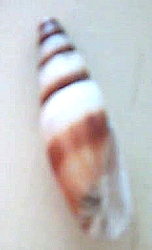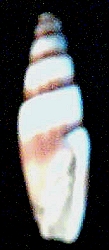|
Identified:
Mitra Zonata
Discussions:
-
This is Mitra zonata Marryat, 1818, a rather uncommon
deep water species ranging from the Canary Islands to Morocco, and
the western Mediterranean.
-
See Eddy Hardie's site at: http://www.gastropods.com/0/Shell_3460.html
-
This is a rather beachworn Mitra zonata Marrat, 1817 ... Paul
M.
-
Frederick Marryat (July 10, 1792 – August 9, 1848), a Londoner,
had a distinguished career in the Royal Navy, in which he enlisted
at age 14. He was involved in, and later led, numerous campaigns
including action against the US in the War of 1812. During the post-war
period he devoted time to scientific studies and was admitted to
the Royal Society in 1817, the year he named Mitra zonata.
In 1818 he named Cyclostrema and its type species C. cancellatum.
He resigned his commission in 1830 having achieved the rank of Captain
while in his early thirties and seeing action in places as remote
as St. Helena and Malaysia. His second career was as a novelist,
publishing 27 titles, achieving a modicum of critical acclaim, and
hob-nobbing with the likes of Charles Dickens. It seems he never
re-immersed himself in conchology. There are biographies at <
http://www.athelstane.co.uk/marryat/life.htm>
and < http://www.athelstane.co.uk/marryat/marryat2.htm>.
-
According to Dance (1986) Frederick Price Marrat was born in
1820. His sentinel contributions to malacology include the curation
of the fellow Liverpudlian John Dennison (of Lovell Reeve's Morum
and Vexillum dennisoni fame)** and authoring the Oliva
monograph in Thesaurus Conchyliorum in 1871. He was also a highly-regarded
paleobotanist. There is a good biobibliography, etc. by Nora McMillan
(1985).
** These two patronymics place John Dennison with Sir David
William Barclay (the muricid Naquetia barclayi and cowrie
Contradusta barclayi both also named by Reeve) as the only
conchologists celebrated with two patronymics among the 50 species
selected by Peter Dance (1969) as the world's rarest shells. Another
of the august 50 is Cypraea nivosa Broderip, 1837, the type
of which was brought back by none other than Frederick Marryat from
his Asian campaign.
Harry G.
Dance, S. P., 1969. Rare shells. University of California, Berkeley.
pp. 1-128 + 45 pls. (only pl. I paginated).
Dance, S. P., 1986. A history of shell collecting. E. J. Brill -
Dr. W. Backhuys, Leiden, 1986, pp. 1-265 + xv + 32 pls. + frontispiece.
McMillan, N., 1985. Frederick Price Marrat, 'conchologist, etc.':
with a list of his type and figured specimens in Merseyside County
Museums, and a bibliography of his publications. Merseyside County
Museums, Liverpool. pp. 1-33 ISBN 0906367182.
|

